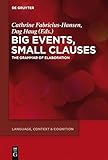Big Events, Small Clauses : The Grammar of Elaboration / ed. by Cathrine Fabricius-Hansen, Dag Haug.
Material type: TextSeries: Language, Context and Cognition ; 12Publisher: Berlin ; Boston : De Gruyter, [2012]Copyright date: ©2012Description: 1 online resource (457 p.)Content type:
TextSeries: Language, Context and Cognition ; 12Publisher: Berlin ; Boston : De Gruyter, [2012]Copyright date: ©2012Description: 1 online resource (457 p.)Content type: - 9783110285802
- 9783110285864
- Grammar, Comparative and general -- Adjuncts
- Grammar, Comparative and general -- Syntax
- Grammar, Comparative and general -- Voice
- Semantics
- Diskursanalyse
- Korpus / Linguistik
- Pragmatik / Sprache
- Semantik
- Syntax
- LANGUAGE ARTS & DISCIPLINES / Linguistics / General
- Corpus (Linguistics)
- Discourse Analysis
- Pragmatics (Language)
- Semantics
- Syntax
- online - DeGruyter
- Issued also in print.
| Item type | Current library | Call number | URL | Status | Notes | Barcode | |
|---|---|---|---|---|---|---|---|
 eBook
eBook
|
Biblioteca "Angelicum" Pont. Univ. S.Tommaso d'Aquino Nuvola online | online - DeGruyter (Browse shelf(Opens below)) | Online access | Not for loan (Accesso limitato) | Accesso per gli utenti autorizzati / Access for authorized users | (dgr)9783110285864 |
Frontmatter -- Contents -- Preface -- List of abbreviations -- Introduction -- Part I: Theoretical issues -- Chapter 1. Co-eventive adjuncts: main issues and clarifications -- Chapter 2. Closed adjuncts: degrees of pertinence -- Chapter 3. Open adjuncts: participial syntax -- Chapter 4. Open adjuncts: degrees of event integration -- Chapter 5. Competing structures: the discourse perspective -- Part II: Language-specific case studies -- CHAPTER 6.1. Possessive absolutes in English and their Norwegian correspondences -- CHAPTER 6.2. On absolutes in French, German, and Norwegian -- Chapter 7. Open verb-headed adjuncts in New Testament Greek and the Latin of the Vulgate -- Chapter 8. The meaning of Russian converbs -- Chapter 9. Participant- and event-oriented adjectival adjuncts in translation German-Norwegian -- Chapter 10. German wobei-clauses in translation -- Summary and final discussion -- References -- Index -- Contributors
restricted access online access with authorization star
http://purl.org/coar/access_right/c_16ec
This book investigates specific syntactic means of event elaborationacross seven Indo-European languages (English, German, Norwegian,French, Russian, Latin and Ancient Greek): bare and comitative smallclauses (“absolutes”), participle constructions and related clause-like butnon-finite adjuncts that increase descriptive granularity with respect toconstitutive parts of the matrix event (elaboration in the narrowestsense), or describe eventualities that are co-located and connectedwith but not part of the matrix event. The book falls in twoparts. Part I addresses central theoretical issues: How is the co-eventiveinterpretation of such adjuncts achieved? What is the internal syntax ofparticipial and converb constructions? How do these constructionsfunction at the discourse level, as compared to various finite structuresthat are available for co-eventive elaboration? Part II takes an empiricalcross-linguistic perspective. It consists of five self-contained chapters thatare based on parallel corpora and study either the use of a specificconstruction across at least two of the seven object languages, or how aspecific construction is rendered in other languages.
Issued also in print.
Mode of access: Internet via World Wide Web.
In English.
Description based on online resource; title from PDF title page (publisher's Web site, viewed 28. Feb 2023)


